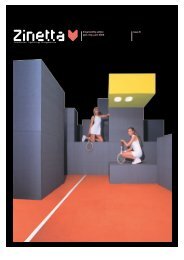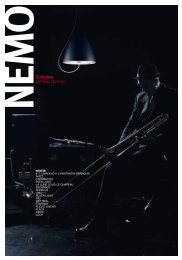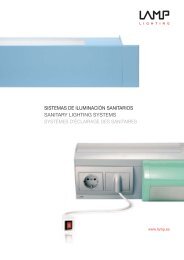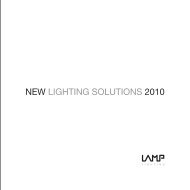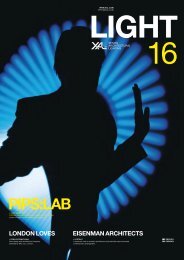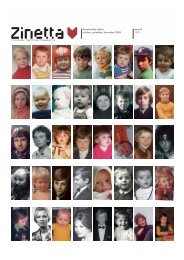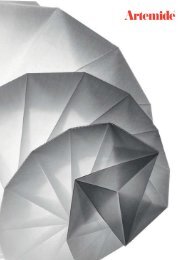Dossier 2008 © - Teclux
Dossier 2008 © - Teclux
Dossier 2008 © - Teclux
You also want an ePaper? Increase the reach of your titles
YUMPU automatically turns print PDFs into web optimized ePapers that Google loves.
metalart e
History<br />
Few companies can claim to have illuminated<br />
the story of Spanish design since the times when<br />
125-volt lamps were in use. Decorative ideas have<br />
changed enormously since then, and Metalarte,<br />
born in metalwork shop, has always been there,<br />
steered by creativity.<br />
The history of Metalarte is the history of a family<br />
firm. Its origins go back to Construcciones Riera,<br />
a company founded by Antonio Riera Clariana<br />
when, in 1932, he decided to establish a metalwork<br />
shop to make the iron pieces needed by the<br />
building firm. In those days metalworkers could<br />
show off their creations on buildings fronts.<br />
They had not yet been forced into retirement<br />
by aluminium carpentry and they were considered<br />
“metal artist” by the applied arts guild. And so<br />
they were. That is why the Riera family called their<br />
first workshop Metalls Artes.<br />
Managed by Antonio Riera, the company ceased<br />
to work only on commission, launching its own<br />
lines of doorknobs, household utensils and stylish<br />
lamps. The first was produced in 1942 and<br />
was baptised, logically enough, as nº1, because<br />
in those days lamps were still not considered<br />
designer objects, nor were they given names.<br />
At that time, Spain was little more than a wasteland,<br />
and the world was at war. Then came the<br />
post-war period, and it was not until the mid-1950’s<br />
that Antonio Riera began to travel to the Nordic<br />
countries, attracted by the siren calls of burgeoning<br />
Scandinavian design. There he found inspiration<br />
for the new collections that Metal Artes launched<br />
onto the market between 1954-1960, illustrated<br />
by a first catalogue of hand-coloured photos.<br />
They were a success those were boom years.<br />
The company became firmly established and began<br />
to be seen as a reference point in the lighting<br />
industry. The company also changed its name once<br />
more, introducing Metalarte and a corporative<br />
image, something quite normal nowadays, but<br />
a distinctly odd-sounding idea in those times.<br />
Antonio Riera wanted to take his company into<br />
the future and even then he was aware that this<br />
meant taking the path of design.<br />
Until then, the lamps from Metal Artes had no<br />
recognised designer, as they were not yet signed.<br />
It is suffice to take a look, however, at the 1959<br />
and 1962 models to see the amazing resemblance<br />
these lamps have with others that can be seen<br />
today in other company showrooms. In fashion,<br />
what goes around comes around. These days, we<br />
seek inspiration in the past, whilst in those bygone<br />
days, when Spain was just starting to shake itself<br />
out of its lethargy; businesses found their inspiration<br />
in Europe, particularly in Italy. Antonio Riera<br />
went a little further, to the United States. More than<br />
inspiration, he was looking for inspired people,<br />
and in New York he found George W. Hansen an<br />
American of Danish origin who, whilst serving<br />
in the army on the Island of Labrador, designed<br />
a lamp that would later become the Swing Arm.<br />
Hansen was the catalyst for Metalarte selling<br />
lamps abroad.<br />
This American-style lamp is still one of the firm’s<br />
biggest sellers, one of those life-long success<br />
stories that are so difficult to achieve, but not<br />
impossible if you try hard enough. With everything<br />
still to do, in those times, Metalarte produced two<br />
lines of products, one neoclassical, the other more<br />
modern in style, designed by the technical<br />
department. The company lived in the present<br />
whilst not forgetting the past.<br />
We are pioneers commissioning design.<br />
André Ricard, today one of the most prestigious<br />
Spanish designers but during the 70s he was<br />
just another promising talent. He came to Metalarte<br />
with a few drawings for a lamp under his arm.<br />
It did not look like a lamp. It was small, with a<br />
twisted shape, supported by three brightly-coloured<br />
ABS arms that gave it a pop look very much in line<br />
with the times. We need to imagine the scene;<br />
what now appears as a regular meeting between<br />
a manufacturer and a designer was, in those days,<br />
a veritable act of faith. Riera’s courage did not<br />
fail him, though, and in 1970 he launched Ricard’s<br />
lamp on the market, the work of one that we<br />
would now call an emerging or up-and-coming<br />
designer. Both Antonio Riera and his brother<br />
Carlos are the kind of people who do not see<br />
business as merely profit and loss, but are capable<br />
of braving unknown territory to put good ideas<br />
into practice. Carlos Riera already knew what it<br />
was like to win a National Design Prize.<br />
He received one during his time in charge of<br />
Disform, also for his pioneering courage.
Future<br />
His was the merit of being the first manufacturer to<br />
produce a design by Philippe Starck. Metalarte has<br />
always been ready to give breaks, and this is part<br />
of its success. In the 1970’s following their<br />
collective nose as ever, they banked on Enrich<br />
Franch, and once more hit the jackpot. Franch’s<br />
Calder (1974), which was Metalarte’s first halogen<br />
lamp, also took the honour of becoming the first<br />
Spanish design to be selected to form part of the<br />
MoMA permanent collection in New York. It is still<br />
there, in the museum and in commerce, a classic of<br />
contemporary design. The company continued to<br />
hire new designers.<br />
Metalarte breezed through the happy 80s as the<br />
prince of Spanish lighting companies. It was time<br />
to venture into the outside world, and preparations<br />
were made to disembark abroad when Román<br />
Riera, son of Antonio and nephew of Carlos, joined<br />
the firm in 1982. Román, who represents the third<br />
generation of his family still remains at the helm of<br />
Metalarte today, extended the sales network and<br />
took on the export market.<br />
Less fortunate was the case with Ross Lovegrove.<br />
This Welsh designer, now internationally renowned,<br />
was given an opportunity. Lovegrove worked with<br />
Julian Brown, and in 1992 the pair jointly designed<br />
a lamp, which went entirely unnoticed. Although<br />
Lovegrove’s designs had still to reach full maturity,<br />
that lamp was not so bad. A few years earlier it<br />
would have sold well, but the economic situation<br />
did not help.<br />
After the Barcelona Olympic Games and the Seville<br />
Expo in 1992, a national crisis set in, seriously<br />
affecting the whole design industry. The market fell<br />
flat. Metalarte suffered as much as anyone during<br />
those difficult years. Only the strongest survived.<br />
In 1997, Román Riera sought to escape the crisis<br />
by injecting more creativity, hiring Carlos Riera as<br />
the company’s Art Director.<br />
With Carlos Riera at the helm of the family business<br />
Metalarte went from strength to strength.<br />
Riera built on his experience at Disform where<br />
he also gained a great deal of notoriety with<br />
established professionals from Lievore to Starck.<br />
To this day Starck still likes to remind people that it<br />
was Riera that gave him his first opportunity. As Art<br />
Director, Carlos Riera is pivotal in the success of<br />
each product ensuring every product is fully<br />
developed prior to being launched.<br />
In 2002, the great challenge came with the new<br />
millennium, when the Feliu de la Peña (Troll) group<br />
took out a majority shareholding, injecting new<br />
resources that enabled the company to undertake<br />
projects of broader scope. New offices were<br />
opened, still in Sant Joan Despí, but with a<br />
completely new look. Outside, the building is<br />
painted in black whilst inside the spacious offices<br />
and showroom are bathed in light. The new<br />
facilities include a technical office that has been<br />
converted into a research laboratory and the huge<br />
warehouse, where lamps are assembled ready for<br />
dispatch. The firm no longer manufactures in old<br />
way, for Metalarte now is a modern company with<br />
suppliers all over the world.<br />
Carlos and Roman Riera are supported by all the<br />
company’s departments and their partner, Feliu de<br />
la Peña, who also knows the market like the back<br />
of his hand. Without their support, the Metalab<br />
collection would never have seen the light day.<br />
Metalab was created to provide an outlet for more<br />
daring projects, those that, at first glance, do not<br />
seem suitable for conventional channels: a lamp<br />
that floats on a swimming pool (Waterproof, Hector<br />
Serrano, 2003); another enormous lamp that can be<br />
used both outdoors and indoors (Inout, Otto<br />
Canalda and Ramón Ubeda, 2003); a collection in<br />
Pyrex (Liquid Lights, Fabrica, 2004), manufactured<br />
without plans or mould; or a luxury lamp that give a<br />
modern touch to the gilt and silver finishes we all<br />
know and love (Josephine, Jaime Hayón, 2004).<br />
Experiments that have later proven to be commerc i a l<br />
successes. Products that close the same cycle that<br />
has been repeated since the very beginning: what<br />
seems surprising at first may later become a classic.<br />
People at Metalarte know this better than anyone,<br />
and that is why they will continue to produce lamps<br />
to light the world, showing us clearly what we can<br />
expect in the future .<br />
In 2003 we went for a<br />
s t r a t e g i c turn around and<br />
a clear bet towards modern<br />
and contemporary design.<br />
F rom 2003 to 2005 Metalarte<br />
was completely focused on<br />
services: quality and delivery<br />
time and the fact that we<br />
a re most proud of is that<br />
we have incorporated<br />
38 new products into the<br />
catalogue in the last 4 years.
P ro d u c t s
1954-1960
1970-1992
1993-2005
<strong>2008</strong>
Young designers
Best sellers<br />
µ in the world<br />
1 In o u t<br />
2 J o s e p h i n e<br />
3 L e w i t<br />
4 D o j o<br />
5 H o p p e r<br />
6 N a w a<br />
7 Josephine Queen<br />
8 L i b r a<br />
9 Hansen Euro p e<br />
10 126 / 170 Hinson<br />
11C o s t u r a<br />
1 2 2344<br />
USA 6%<br />
Spain 45% E u rope 34%<br />
Japan and<br />
Australia 5%<br />
Others 10%<br />
Bespoke solutions<br />
Metalarte’s own technical department<br />
added to the knowledge in materials, gives<br />
us the possibility to develop and manufacture<br />
bespoke solutions, always in the area<br />
of decorative illumination.<br />
µ<br />
does in Europe<br />
around 62%<br />
of its export<br />
turnover<br />
France 17%<br />
Germany 17%<br />
Switzerland 13%<br />
belgium 10%<br />
Sweeden 8%<br />
Austria 7%<br />
Italy 7%<br />
Holland 7%<br />
UK 4%<br />
Turkey 4%
C o m m u n i c a t i o n
1969-1974
2003
2004
F a c t o r y<br />
O ff i c e s<br />
S h o w ro o m
1954 2003




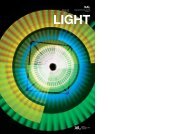

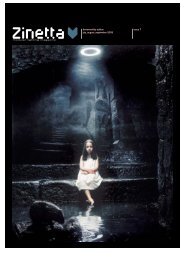

![Lataa tästä Building06 nettikirje [PDF] [591.72 KB] - Teclux](https://img.yumpu.com/41499677/1/184x260/lataa-tasta-building06-nettikirje-pdf-59172-kb-teclux.jpg?quality=85)
